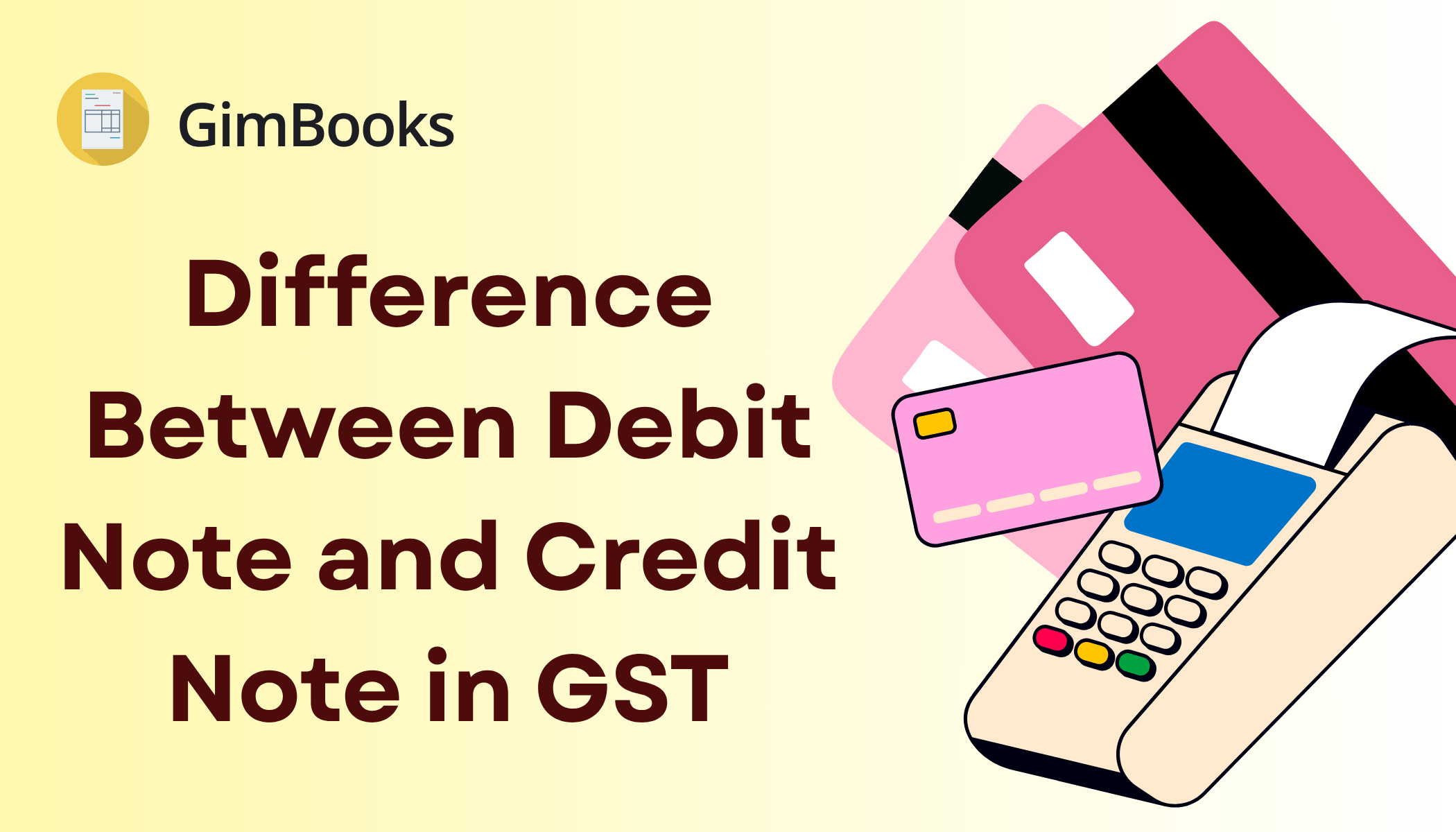Difference Between Debit Note and Credit Note in GST

Understanding the difference between debit notes and credit notes in GST is essential for small and micro-sized businesses.
Whether you run a retail shop, provide services, or manage invoices regularly, knowing how these two documents work can help you stay GST-compliant and avoid confusion in accounting. Let's break it down in simple terms.
What is a Debit Note?
A debit note is a document that a buyer issues to the seller when:
- The buyer receives more goods than ordered.
- The goods received are damaged or defective.
- The price charged is more than agreed.
- There is a need to reverse a part of the earlier purchase.
In simple words, when the buyer needs to reduce the value of a purchase made earlier, they issue a debit note.
Example of a Debit Note: Suppose you ordered 100 shirts, but 10 of them were torn. You send a debit note to the seller to reduce the invoice by the value of 10 shirts.
What is a Credit Note?
A credit note is issued by the seller to the buyer when:
- The goods returned by the buyer are accepted.
- There is a mistake in the invoice, such as overcharging.
- Discounts or promotional offers need to be applied later.
- The buyer has paid more than required.
So, when a seller agrees to reduce the amount payable by the buyer, a credit note is issued.
Example of a Credit Note: If the buyer returns damaged goods, the seller issues a credit note to reduce the earlier invoice amount.
Debit Note and Credit Note in GST
Both debit note and credit note in GST help businesses correct their invoices and keep the tax system clean.
GST Rules for Debit Note
- The seller must declare it in the GST return of the month in which it is issued.
- It increases the taxable value or tax charged earlier.
GST Rules for Credit Note
- The seller can reduce their output tax liability.
- It should be declared in the return for the month it is issued, but not later than November of the next financial year or filing of the annual return (whichever is earlier).
Who Issues Debit Notes and Who Issues Credit Notes?
Let’s clear the common confusion around who issues debit notes and who issues credit notes:
Debit Note vs Credit Note
Here’s a quick look at the debit note vs credit note comparison:
Is Purchase Return Debit or Credit?
A purchase return is debited in the buyer’s books because the buyer is reducing the amount they owe to the seller. So, they issue a debit note.
Is Sales Return Debit or Credit?
A sales return is credited to the seller’s books. It is because the seller is reducing the amount the buyer has to pay. Hence, the seller issues a credit note.
When is a Credit Note Issued?
A credit note is issued when:
- The buyer returns goods.
- There is an invoice error (e.g., overcharging).
- Discounts need to be applied after billing.
- Services were not delivered as promised.
When is a Debit Note Issued?
A debit note is issued when:
- The buyer is overcharged and wants to adjust the purchase.
- Goods are received in excess or poor condition.
- There's a mismatch between the invoice and the goods received.
Real-Life Scenarios for Better Understanding
Scenario 1: Overbilling
- A supplier sends an invoice for ₹10,000.
- But the agreed value was ₹9,000.
- The buyer sends a debit note for ₹1,000.
Scenario 2: Product Return
- Buyer returns ₹500 worth of products.
- The seller issues a credit note for ₹500.
How Debit Notes and Credit Notes Affect GST Filing
Understanding the difference between debit notes and credit notes isn’t just important for internal records; it also plays a key role in GST compliance.
1. Input Tax Credit (ITC) Adjustments
- When a credit note is issued, the supplier must reduce their GST liability in GSTR-1.
- The buyer also needs to reduce their Input Tax Credit if they already claimed it on the original invoice.
2. Time Limits Under GST
- Credit notes must be declared before September of the next financial year or before filing the annual return, whichever is earlier.
- If missed, GST adjustments will not be allowed.
3. GSTR-1 and GSTR-3B Reporting
- Debit and credit notes must be reported in GSTR-1 by the issuer (seller for credit notes, buyer for debit notes).
- Both parties must reflect the changes in GSTR-3B, ensuring proper reconciliation.
4. Matching and Reconciliation
- If debit and credit notes are not matched properly between buyer and seller, it may lead to mismatches in GST returns.
- It can delay refunds or cause penalties.
Also check - Difference Between GSTR 2A and 2B
Importance of Understanding Debit and Credit Notes
Small and micro businesses often deal with regular returns, corrections, and disputes. Understanding these documents helps to:
- Maintain accurate financial records.
- Avoid GST mismatches and penalties.
- Reduce manual errors and confusion.
How GimBooks Helps with Debit and Credit Notes
Managing multiple invoices, returns, and corrections can be tough, especially if you're using traditional methods. That’s where GimBooks comes in.
GimBooks is a cloud-based and mobile-first platform made especially for small and micro-sized businesses in India and the Middle East. It helps businesses manage their books easily, even without any formal accounting knowledge.
Why Use GimBooks for Debit and Credit Notes?
- GST-compliant invoicing with debit and credit note support.
- Easily generate and manage notes from mobile or desktop.
- Automatically adjusts taxable values and helps maintain GST records.
- Helps avoid late filings and mismatches in GST returns.
- No technical or accounting background is needed.
From issuing debit notes to handling credit notes and correcting tax values, GimBooks makes it simple and error-free for every business owner.
Closing Up
The difference between debit notes and credit notes might look confusing at first, but it plays a major role in your day-to-day accounting. Whether you’re dealing with a sales return debit or credit situation or unsure when a credit note is issued, remember:
- Buyers issue debit notes when they want to reduce a purchase.
- Sellers issue credit notes when they agree to reduce a sale.
Instead of juggling papers and spreadsheets, let GimBooks simplify everything. It’s built with business owners like you in mind easy, smart, and made for GST.
Explore more at GimBooks and make your bookkeeping smarter today! You can also explore GimBook's informative blogs!
FAQs
1. What are the debit notes and credit notes with examples?
The difference between a debit note and a credit note can be explained with an example: If a buyer returns damaged goods, they issue a debit note. The seller responds with a credit note to adjust the invoice.
2. Is credit note sales return or purchase return?
A credit note is a sales return. It’s issued by the seller when the buyer returns goods, showing the difference between a debit note and a credit note; clearly buyer issues a debit, seller issues credit.
3. What is the key difference between debit notes and credit notes in GST?
The key difference between debit notes and credit notes in GST is their direction. Debit notes increase invoice value, while credit notes reduce it, helping to correct billing under GST.
4. Who issues a credit note, and why in GST?
A credit note is issued by the seller when goods are returned or overcharged. It shows the difference between debit notes and credit notes, as buyers issue debit notes.
5. Is sales return debit or credit in GST?
In GST, a sales return is credited because the seller issues a credit note. It helps clarify the difference between debit notes and credit notes, debit for purchase returns, and credit for sales returns.
